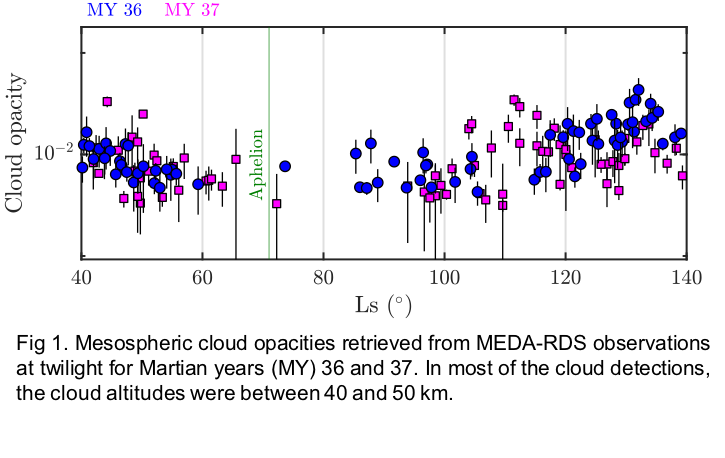- 1Instituto Nacional de Técnica Aeroespacial (INTA), Madrid, Spain
- 2GSMA, UMR 7331-GSMA, Universite de Reims Champagne-Ardenne, 51687 Reims, France
- 3Lunar and Planetary Institute, Universities Space Research Association, Houston, TX, USA
- 4Jet Propulsion Laboratory, California Institute of Technology, Pasadena, CA, USA
- 5Universidad del País Vasco UPV/EHU, Bilbao, Spain
- 6Johns Hopkins Applied Physics Laboratory, Laurel, MD, USA
- 7IRAP - Institut de Recherche en Astrophysique et Planétologie, Toulouse, France
- 8Laboratoire Atmosphères Milieux Observations Spatiales (LATMOS), Université Paris-Saclay, Sorbonne Université, Centre National de la Recherche Scientifique, Guyancourt, France
- 9NASA Goddard Space Flight Center, Greenbelt, MD, USA
- 10Space Science Institute, Boulder, CO, USA
- 11Centro de Astrobiología (INTA-CSIC), Torrejón de Ardoz, Madrid, Spain
- 12Aeolis Research, Chandler, AZ, USA
- 13LESIA, Observatoire de Paris, Meudon, France
- *A full list of authors appears at the end of the abstract
Clouds play a crucial role in the past and current climate of Mars. Cloud particles impact the planet's energy balance and atmospheric dynamics, as well as influence the vertical distribution of dust particles through dust scavenging. This process of dust scavenging by clouds has significant consequences for the planet's water cycle. For example, regions in the atmosphere with insufficient quantities of dust particles, or condensation nuclei, can inhibit the formation of H2O clouds, leading to the presence of water vapor in excess of saturation [1]. Recent observations made by the MEDA Radiation and Dust Sensor (RDS) [2,3] have shown a marked decline in mesospheric cloud activity (above 35-40 km) when Mars is near its aphelion (within the Aphelion Cloud Belt-ACB season), notably occurring during solar longitudes (Ls) between Ls 70° and 80° [4] (see Figure 1).
In order to investigate the possible factors leading to this decrease in water ice abundance, we used a one-dimensional cloud microphysical model [5,6], which includes the processes of nucleation, condensation, coagulation, evaporation, precipitation, and coalescence, and where the vertical mixing is parameterized using an eddy diffusion profile (Keddy). Combining cloud microphysics modeling with ground-based (Mars 2020 and InSight) and orbital observations (TGO and MRO) of clouds, water vapor, and temperature, we will discuss in this presentation the main factors controlling the water abundance in the Martian mesosphere during the ACB season.
References: [1] Maltagliati, Luca, et al. "Evidence of water vapor in excess of saturation in the atmosphere of Mars." science 333.6051 (2011): 1868-1871. [2] Apestigue, V., et al. “Radiation and Dust Sensor for Mars Environmental Dynamic Analyzer Onboard M2020 Rover”. Sensor 22.8 (2022): 2907. [3] Rodriguez-Manfredi, Jose Antonio, et al. “The Mars Enviromental Dynamics Analyzer, MEDA. Asuite of enviromental sensors for the Mars 2020 mission.” Space science reviews 217.3 (2021): 1-86. [4] Toledo, D., et al. “Measurement of aerosol optical depth and sub-visual cloud detection using the optical depth sensor (ODS)”. Atmospheric Measurement Techniques 9.2 (2016): 455-467. [5] Montmessin, F., Rannou, P., Cabane, M.: New insights into martian dust distribution and water-ice cloud microphysics. Journal of Geophysical Research: Planets 107(E6), 41 (2002). [6] Rannou, P., Montmessin, F., Hourdin, F., Lebonnois, S.: The latitudinal distribution of clouds on titan. science 311(5758), 201205 (2006).

Jorge Pla-Garcia11, Margarita Yela1, Manuel de la Torre Juarez4, Jose Antonio Rodriguez-Manfredi11
How to cite: Toledo, D., Rannou, P., Apestigue, V., Rodriguez-Veloso, R., Arruego, I., Martinez, G., Tamppari, L., Munguira, A., Lorenz, R., Stcherbinine, A., Montmessin, F., Sanchez-Lavega, A., Patel, P., Smith, M., Lemmon, M., Vicente-Retortillo, A., Newman, C., Viudez-Moreiras, D., Hueso, R., and Bertrand, T. and the +4: Decline in Water Ice Abundance in the Martian Mesosphere during Aphelion, Europlanet Science Congress 2024, Berlin, Germany, 8–13 Sep 2024, EPSC2024-504, https://doi.org/10.5194/epsc2024-504, 2024.